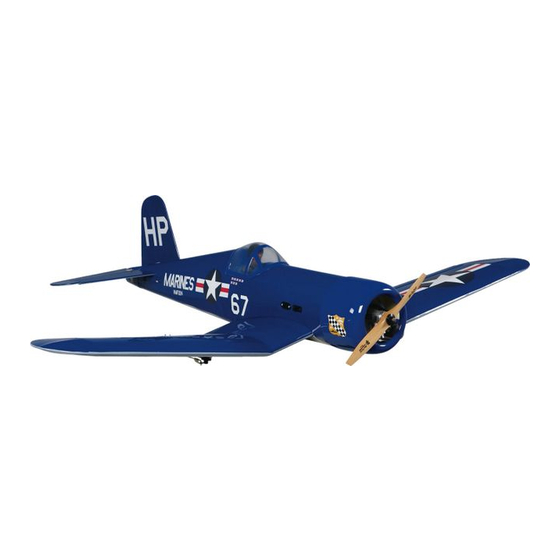GREAT PLANES Combat Corsair Buku Petunjuk - Halaman 15
Jelajahi secara online atau unduh pdf Buku Petunjuk untuk Mainan GREAT PLANES Combat Corsair. GREAT PLANES Combat Corsair 20 halaman. 1/12 scale ama event 750, class 2610 arf

GET THE MODEL READY TO FLY
Check the Control Directions
1. Turn on the transmitter and receiver and center the
trims. If necessary, remove the servo arms from the servos
and reposition them so they are centered. Reinstall the
screws that hold on the servo arms.
2. With the transmitter and receiver still on, check all the
control surfaces to see if they are centered. If necessary, adjust
the clevises on the pushrods to center the control surfaces.
4-CHANNEL RADIO SETUP
(STANDARD MODE 2)
4-CHANNEL
TRANSMITTER
ELEVATOR MOVES UP
4-CHANNEL
TRANSMITTER
RIGHT AILERON MOVES UP
LEFT AILERON MOVES DOWN
3. Make certain that the control surfaces and the
carburetor respond in the correct direction as shown in the
diagram. If any of the controls respond in the wrong direction,
use the servo reversing in the transmitter to reverse the
servos connected to those controls. Be certain the control
surfaces have remained centered. Adjust if necessary.
Set the Control Throws
Use a Great Planes AccuThrow (or a ruler) to accurately
measure and set the control throw of each control surface as
indicated in the chart that follows. If your radio does not have
dual rates, we recommend setting the throws at the low rate
setting. NOTE: The throws are measured at the widest part
of the elevators, rudder and ailerons.
4-CHANNEL
TRANSMITTER
RUDDER MOVES RIGHT
4-CHANNEL
TRANSMITTER
CARBURETOR WIDE OPEN
These are the recommended control surface throws:
High Rate
ELEVATOR:
3/8" [9.5mm] up
3/8" [9.5mm] down
AILERONS:
3/8" [9.5mm] up
3/8" [9.5mm] down
IMPORTANT: The Combat Corsair has been extensively
flown and tested to arrive at the throws at which it flies
best. Flying your model at these throws will provide you
with the greatest chance for successful first flights. If, after
you have become accustomed to the way the Combat
Corsair flies, you would like to change the throws to suit
your taste, that is fine. However, too much control throw
could make the model difficult to control, so remember,
"more is not always better."
Balance the Model (C.G.)
More than any other factor, the C.G. (balance point) can
have the greatest effect on how a model flies and may
determine whether or not your first flight will be
successful. If you value this model and wish to enjoy it for
many flights, DO NOT OVERLOOK THIS IMPORTANT
PROCEDURE. A model that is not properly balanced will
be unstable and possibly unflyable.
At this stage the model should be in ready-to-fly condition
with all of the systems in place.
1. Use a felt-tip pen or 1/8" [3mm]-wide tape to accurately
mark the C.G. on the top of the wing on both sides of the
fuselage. The C.G. is located 2-1/2" [64mm] back from
the leading edge of the wing measured at the fuselage.
This is where your model should balance for the first
flights. Later, you may wish to experiment by shifting the
C.G. up to 1/8" [3mm] forward or 1/8" [3mm] back to
change the flying characteristics. Moving the C.G. forward
may improve the smoothness and stability, but the model
may then require more speed for takeoff and make it more
difficult to slow for landing. Moving the C.G. aft makes the
model more maneuverable, but could also cause it to
become too difficult to control. In any case, start at the
recommended balance point and do not at any time
balance the model outside the specified range.
2. With the wing attached to the fuselage, all parts of the
model installed (ready to fly) and an empty fuel tank, place
the model upside-down on a Great Planes CG Machine, or
lift it upside-down at the balance point you marked.
15
Low Rate
7/32" [5.5mm] up
7/32" [5.5mm] down
1/4" [6mm] up
1/4" [6mm] down
